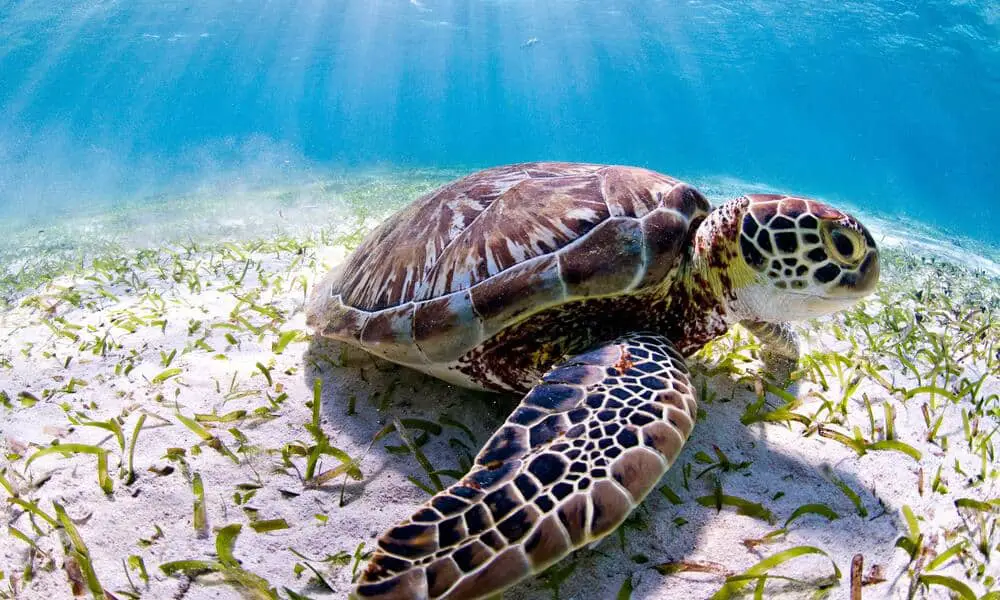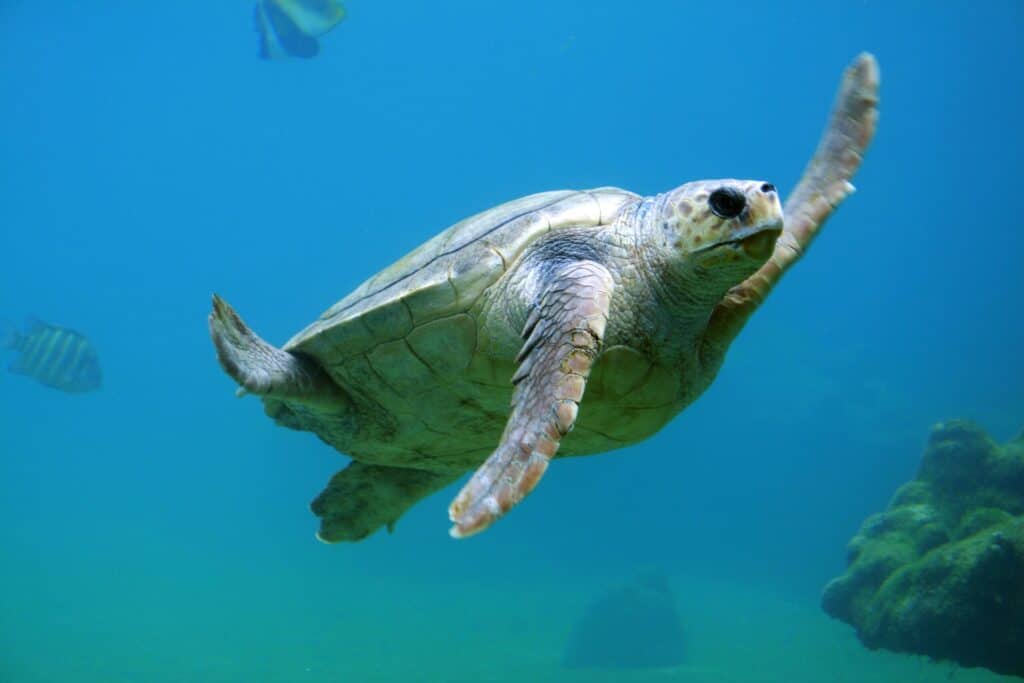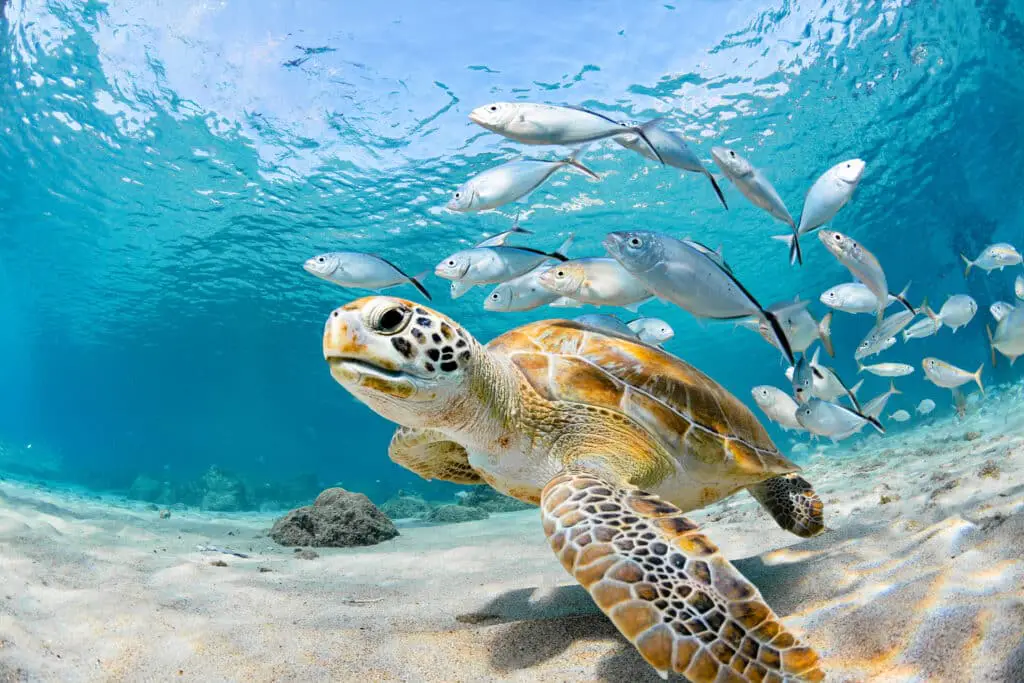Are Sea Turtles Friendly

Introduction
Are Sea Turtles Friendly: Sea turtles, majestic inhabitants of our planet’s oceans, have long captured the imagination of nature enthusiasts and conservationists alike. These ancient reptiles, whose lineage dates back over 100 million years, hold a unique place in the world’s ecosystems. One of the intriguing questions that surround these enigmatic creatures is whether they can be considered friendly.
Sea turtles, comprising various species such as the loggerhead, green, leatherback, hawksbill, and Kemp’s ridley, are renowned for their distinct characteristics and behaviors. Their gentle and graceful movements as they glide through the water have earned them a reputation as serene beings of the sea.
To address this question, we delve into the multifaceted world of sea turtles. We explore their social interactions, migratory patterns, and feeding habits to gain insight into their ecological roles and their interactions with other species. Additionally, we examine their encounters with humans, shedding light on the impact of human activities, such as habitat destruction and plastic pollution, on their perceived friendliness.
Join us on this journey beneath the waves as we unravel the mystery of whether sea turtles are indeed friendly creatures of the deep or if their seemingly peaceful demeanor hides a more complex truth.

Do sea turtles make friends?
Sea turtles are generally solitary creatures that remain submerged for much of the time they are at sea, which makes them extremely difficult to study. They rarely interact with one another outside of courtship and mating. Ridleys, however, do come together in massive groups during nesting.
Sea turtles, as solitary and migratory creatures, do not form friendships in the same way humans or some other social animals do. They typically lead independent lives, driven by instinctual behaviors and survival strategies rather than social bonds.
However, it’s essential to understand that while sea turtles do not have friendships in the human sense, they may interact with other turtles in certain situations. For example, during mating season, male and female sea turtles come together briefly to mate, but these encounters are primarily driven by reproductive instincts rather than emotional connections.
Additionally, sea turtles may sometimes share a nesting beach or foraging grounds, and you might observe multiple turtles in close proximity. However, these interactions are more about resource availability and environmental factors than forming friendships.
Sea turtles are fascinating creatures with unique and complex behaviors, but they do not make friends in the way humans do. Their interactions with other turtles are largely driven by their biological and ecological needs rather than social or emotional connections.
Are sea turtles ever aggressive?
By nature, sea turtles are not aggressive animals, although males during the mating season may display signs of territoriality and dominance, using their strong bite.
Sea turtles are generally not considered aggressive animals. In fact, they are known for their gentle and peaceful nature. These ancient marine reptiles typically exhibit a calm demeanour and are more focused on survival and navigation rather than aggressive behaviours.
However, it’s important to note that like any wild animal, sea turtles may display defensive behaviors if they feel threatened or cornered. If a sea turtle perceives a threat, it may hiss or attempt to snap with its beak-like mouth as a means of defense. This is more common in situations where the turtle feels stressed or harassed by human interference, such as handling or crowding during nesting or hatchling release activities.
In their natural environment, sea turtles are not aggressive towards other marine life or humans who observe them from a respectful distance. Conservation efforts stress the importance of maintaining a safe and non-intrusive distance when encountering these remarkable creatures in the wild to ensure both their well-being and our safety.
While sea turtles are not inherently aggressive, they may exhibit defensive behaviors when they feel threatened or stressed, emphasizing the need for responsible and respectful interactions with these magnificent marine animals.
Is sea turtle good luck?
Sea turtles are a good omen. They are believed to bring luck and wealth to those who encounter them. As such, they are often venerated as sacred animals. In some parts of the world, it is even said that when a sea turtle lays its eggs on the shore, it is a sign that money is coming.
In many cultures around the world, sea turtles are often associated with good luck, longevity, and wisdom. These ancient marine reptiles have garnered symbolic significance due to their remarkable journeys across vast oceans and their ability to adapt to life in both land and sea. Here are a few reasons why sea turtles are considered symbols of good luck:
Longevity: Sea turtles are known for their impressive lifespans, with some species living for several decades or even over a century. This longevity is often seen as a symbol of endurance and good fortune.
Natural Navigation: Sea turtles possess an innate ability to navigate across the open ocean, returning to the same nesting beaches where they were born. This remarkable sense of direction is often associated with wisdom and a sense of purpose.
Conservation Efforts: The conservation of sea turtles has become a global effort, drawing attention to the importance of preserving these magnificent creatures and their habitats. Many believe that supporting such conservation efforts brings good karma and positive energy.
Spiritual Significance: In some indigenous cultures, sea turtles are revered as spiritual beings, representing connections to ancestral wisdom and the natural world.
While sea turtles themselves do not bring luck in a literal sense, they have become powerful symbols of hope, resilience, and the importance of protecting the planet’s biodiversity. Many people view encounters with these majestic animals as fortunate and memorable experiences, reinforcing their belief in the idea that sea turtles bring a touch of luck to those who encounter them.
Are sea turtles peaceful?
Sea turtles are seen as peaceful, wise, mysterious and interesting ocean ambassadors that travel the world and symbolize the great unknown sea.
Sea turtles are generally peaceful creatures that exhibit calm and gentle behaviors. Their tranquil nature is evident in their graceful movements as they navigate through the water, appearing to glide effortlessly. While they are not aggressive by nature, it’s essential to understand the context of their interactions within the marine ecosystem.
Sea turtles are primarily herbivores or omnivores, depending on their species. They feed on sea grasses, algae, jellyfish, and various marine invertebrates, and their feeding habits are not driven by aggression but by the need to sustain themselves. These creatures are not territorial and do not engage in aggressive behaviors for dominance or territory like some other marine species.
However, sea turtles may exhibit defensive behaviors when they feel threatened. They have powerful flippers and sharp beaks that can be used to ward off potential predators or perceived threats. Such defensive actions are a survival instinct rather than acts of aggression.
In essence, while sea turtles are peaceful in their day-to-day activities and interactions with other marine life, they do possess the means to defend themselves when necessary. Their peaceful presence in the oceans serves as a reminder of the delicate balance of marine ecosystems and the importance of preserving their habitats to ensure their continued existence.
Is it OK to help a sea turtle?
Remember, sea turtles are protected by law – Stay back and give sea turtles space if you see one on the beach at night. Don’t touch a nesting turtle because it may leave the beach without nesting if disturbed. Remember, it is illegal to harm or disturb nesting sea turtles, their nests, eggs or hatchlings.
Helping a sea turtle in distress is a commendable and responsible action, but it’s essential to approach such situations with care and awareness of best practices. Sea turtles, like all wild animals, can benefit from human assistance in specific situations:
- Entanglement: If you encounter a sea turtle entangled in fishing nets, lines, or marine debris, it is crucial to act swiftly. Safely and gently remove the entanglement without causing harm to yourself or the turtle. This intervention can save the turtle’s life and prevent further suffering.
- Injury: If you come across an injured or stranded sea turtle, contact local wildlife authorities or rescue organizations immediately. Do not attempt to handle the turtle yourself, as they may have specific injuries or illnesses that require professional care.
- Nesting: During nesting season, sea turtles often come ashore to lay their eggs. Observing from a respectful distance and refraining from using flashlights or disturbing the nesting process is crucial to ensuring the safety of both the turtles and their hatchlings.
- Hatchlings: If you encounter sea turtle hatchlings making their way to the ocean, keep your distance and avoid using artificial lighting, as this can disorient them. Let them naturally find their way to the water, as this is a critical part of their life cycle.
In all cases, it is essential to prioritize the welfare and conservation of sea turtles. Interfering with healthy, free-roaming turtles or engaging in activities that disrupt their natural behaviors can be harmful. Always consult with local experts and follow established guidelines to ensure your actions are in the best interest of these magnificent creatures and their fragile ecosystems.
Can I touch or interact with sea turtles if I encounter them in the ocean?
It is generally not advisable to touch or interact with sea turtles if you encounter them in the ocean. While these magnificent creatures may appear docile, they are wild animals and should be observed from a respectful distance for several important reasons:
- Stress and Disruption: Approaching or touching sea turtles can cause them stress and disrupt their natural behaviors. Such interference may lead to negative consequences for their health and wellbeing.
- Human Safety: Sea turtles, especially the larger species, can be surprisingly powerful and have sharp beaks. Attempting to touch or interact with them can pose a risk to your safety, as they may react defensively.
- Disease Transmission: Handling sea turtles without proper training and protective measures can pose a risk of disease transmission between humans and these animals.
- Legal Protections: Many species of sea turtles are protected by laws and international agreements due to their endangered status. Interfering with them in any way can result in legal consequences.
- Conservation: By maintaining a respectful distance and observing sea turtles without direct interaction, you contribute to their conservation by minimizing human impact on their natural behavior and habitat.
If you encounter a sea turtle in the ocean, it’s best to enjoy the experience from a distance and refrain from attempting to touch, ride, or feed them. Responsible and ethical wildlife viewing practices help protect these remarkable creatures and preserve the delicate balance of marine ecosystems they inhabit.
Are there any circumstances where sea turtles might approach humans?
There are circumstances where sea turtles might approach humans, although these interactions are typically a result of natural curiosity or environmental factors rather than deliberate seeking of human contact:
- Cleaning Stations: Certain fish species, known as cleaner fish, provide a service by removing parasites and debris from sea turtles’ shells. Sea turtles may approach these cleaning stations, where cleaner fish are abundant, to benefit from this cleaning process.
- Feeding: In some areas, sea turtles may approach humans if they associate them with a source of food. This can occur if people regularly feed sea turtles, intentionally or unintentionally, by discarding bait or fish scraps into the water.
- Nesting: Female sea turtles come ashore to lay their eggs during nesting season. While they typically prefer quiet and undisturbed beaches, they may encounter humans during this critical phase of their life cycle.
- Research and Conservation Activities: Researchers and conservationists who work with sea turtles may occasionally have close encounters with these animals during tagging, monitoring, or rescue efforts. These interactions are conducted with the utmost care and respect for the animals’ well-being.
It’s important to note that even in these situations, maintaining a respectful distance and minimizing disturbance is crucial. Sea turtles are still wild animals, and human interactions can be stressful for them. Responsible and ethical conduct is essential to ensure that these interactions do not harm or disrupt the natural behaviors of these incredible marine creatures.
Are hatchling sea turtles friendly when they emerge from the nest?
When hatchling sea turtles emerge from their sandy nests, they exhibit a remarkable blend of innocence and determination. While the term “friendly” may not accurately describe their behavior, hatchlings are inherently driven by their survival instincts. These tiny, vulnerable creatures, no larger than a human palm, are primarily focused on a single goal: reaching the safety of the ocean.
Hatchling sea turtles are not inherently aggressive or hostile towards humans or other creatures, but their primary instinct is to navigate towards the natural light of the horizon, which is typically the moonlight reflecting off the water. This is crucial for their survival, as it leads them to the ocean where they can begin their incredible journey across vast distances. However, interactions with humans and artificial lights can often disrupt this crucial process, leading hatchlings away from their intended destination.
Efforts to conserve these remarkable creatures often involve careful monitoring and guiding them to the water without interference. So, while hatchling sea turtles may not display friendliness in the conventional sense, they certainly evoke our empathy and inspire us to protect their fragile existence as they embark on their perilous journey into the depths of the sea.

Conclusion
While they exhibit grace and serenity in their movements, the concept of friendliness is multifaceted when applied to animals that operate within the intricate web of marine ecosystems.
Sea turtles, by their very nature, play crucial roles in maintaining the balance of ocean ecosystems. Their interactions with other species, from providing habitats for barnacles and small fish to aiding coral reef health through their grazing, demonstrate their significance in maintaining the vitality of the oceans. However, these interactions are not driven by friendship in the human sense but rather by ecological necessity.
When it comes to their encounters with humans, sea turtles are susceptible to the consequences of human activity, including habitat destruction, pollution, and accidental harm from fishing operations. These interactions highlight the fragility of their existence and the importance of responsible stewardship of marine environments.
The question of sea turtles friendliness is perhaps best reframed as an exploration of their vital role in marine ecosystems and the shared responsibility we have in safeguarding their habitats and well-being. While they may not exhibit friendliness as humans understand it, their importance in preserving the health of our oceans makes them deserving of our respect, protection, and conservation efforts.



